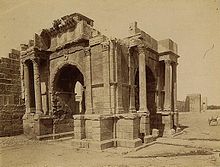Theveste
 Arch of Caracallain Theveste | |
| Location | Algeria |
|---|---|
| Region | Tébessa Province |
| Coordinates | 35°24′00″N8°07′00″E/ 35.4°N 8.116667°E |
Thevestewas aRomancolony situated in what is nowTébessa,Algeria.[1]
History
[edit]In 146 BC, the Romans conquered the region, where existed an old city called "Tbessa".Theveste was founded by the Romans in 75 AD near an old Berber village located next to theAurès Mountains,in order to control the mountain region.
During the 1st century CE, theLegio IIIAugusta[2]resided there before being transferred toLambaesis.It was made acoloniaprobably underTrajan.[3]
Theveste flourished underSeptimius Severusreaching a population calculated in nearly 30,000 inhabitants, and was even an important Dioceses See.
There is mention of a council held there by theDonatists.Among its saints wereLucius,its bishop, who assisted at theCouncil of Carthage (256)and died as a martyr two years later;Maximilianus,martyred 12 March, 295 AD; andCrispina,martyred 5 December, 304 AD.[4]Some of its bishops are known:Romulusin 349 AD;Urbicusin 411 AD;Felixexiled by theVandalsin 484 AD; andPalladiusmentioned in an inscription.
During the 4th and 5th century AD, Thebeste was a centre ofManichaeismas well. In June 1918 a codex of 26 leaves written in Latin by Manichaeans was discovered in a cave near the city.[5]
Theveste was raided by theVandals,but it was rebuilt and made part ofByzantine North Africaat the beginning of the reign ofJustinian Iby thepatriciusSolomon.He erected a tomb there, which still exists. The city was nearly destroyed byUmayyad Caliphateforces, but a small village (probably initially populated by a few surviving Christian Berbers) remained for centuries.[6]
Modern Tebessa is very rich in ancient monuments, among them being atriumphal archofCaracalla,a temple, a Christianbasilicaof the 4th century and the huge walls.
Main architectural remains
[edit]
Around the Roman Forum it is possible to see even today the remains of:
- Arch of Caracalla,a Romantriumphal archdating from 214 AD. This edifice, which was the North entrance to the town is positioned as a square at the junction of two roads. The four facades of this door are all identical.
- Temple of Minerva(early 3rd century AD), with walls decorated by mosaics. The Minerva Temple dates from the beginning of the 3rd Century. The interior walls of this Temple are ornamented with beautiful mosaics. One finds inside it various prehistoric articles (money, arms, lamps, etc.)
- Remains of theBasilica of St. Crispinus(4th century AD), one of the biggest in Africa. It also has chapels, baptism urns, catacombs and gardens. The basilica is situated at the exterior of the old city at the north of the Arc of Caracalla. There are various pathways, huge steps, stables, walkways, and many Roman edifices around. This basilica is consecrated to a local Saint, Saint Crispina, and dates from the end of the 4th Century.
- Byzantine walls(6th century), popularly known as "Solomon's Walls" and flanked by thirteen square towers. The Solomon wall encircles the old town centre. These walls are flanked by towers which open onto the outside by four doors. One of these four doors is an Arc de Triomphe (Caracalla's door).
- Roman theatre.Small in size, it was created when the city was refounded as a base for the Legio III Augusta.
- Amphitheatre(4th century AD). Divided into two sections.
- Roman aqueduct.Still partially working.

See also
[edit]Notes
[edit]- ^"Algerien".www.aeria.phil.uni-erlangen.de.Archived fromthe originalon 2016-12-08.Retrieved2018-01-29.
- ^"Legio III Augusta - Livius".www.livius.org.Archivedfrom the original on 2014-11-08.Retrieved2018-01-29.
- ^"THEVESTE in" Enciclopedia dell' Arte Antica "".www.treccani.it(in Italian).Archivedfrom the original on 2019-08-08.Retrieved2018-01-29.
- ^"CATHOLIC ENCYCLOPEDIA: St. Crispina".www.newadvent.org.Archivedfrom the original on 2019-08-08.Retrieved2018-01-29.
- ^A month laterHenri Omontfound the missing initial 13 leaves. The whole book is now known as theTebessa codexand it is kept in Cologne. It has been edited by Markus Stein (Bonn).
- ^Under theOttoman Empire,Theveste had a garrison ofJanizaries.In 1851 it has been occupied by the French. Under the name ofTebessait became the capital of a canton of the Department of Constantine in Algeria.
Bibliography
[edit]- Laffi, Umberto.Colonie e municipi nello Stato romanoEd. di Storia e Letteratura. Roma, 2007ISBN8884983509
- Mommsen, Theodore.The Provinces of the Roman EmpireSection: Roman Africa. (Leipzig 1865; London 1866; London: Macmillan 1909; reprint New York 1996) Barnes & Noble. New York, 1996
- Smyth Vereker, Charles.Scenes in the Sunny South: Including the Atlas Mountains and the Oases of the Sahara in Algeria.Volume 2. Publisher Longmans, Green, and Company. University of Wisconsin. Madison,1871 (Roman Theveste)
External links
[edit]- Images of Theveste (Tebessa)in Manar al-Athar digital heritage photo resource
![]() This article incorporates text from a publication now in thepublic domain:Herbermann, Charles, ed. (1913). "Theveste".Catholic Encyclopedia.New York: Robert Appleton Company.
This article incorporates text from a publication now in thepublic domain:Herbermann, Charles, ed. (1913). "Theveste".Catholic Encyclopedia.New York: Robert Appleton Company.


